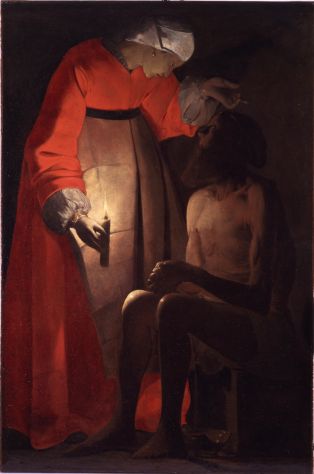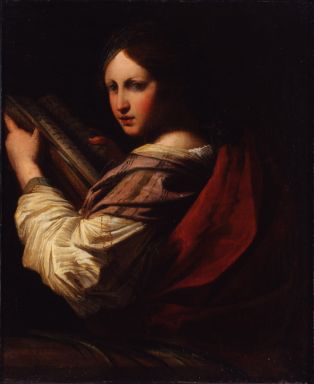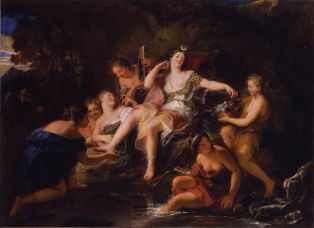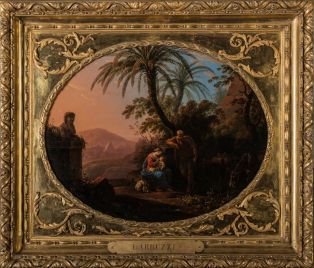- Découvrez les collections
- Notice d'oeuvre



Rome, 1748 ; Pérouse, 1817
1775
H. 37,3 cm ; l. 47 cm (sans cadre) ; H. 57 cm ; l. 66 cm (avec cadre)
M0536_L.I.37
La scène est tirée de la Bible (Mt 2,13-23) : peu après la naissance de Jésus, la sainte Famille doit se réfugier en Égypte pour fuir le roi Hérode. Celui-ci, souhaitant éliminer le futur « roi des Juifs », a en effet décidé de mettre à mort tous les enfants mâles âgés de moins de deux ans. "Le Repos de la sainte Famille" représente l’une des haltes pendant la fuite vers l’Égypte. On reconnaît Marie allaitant Jésus, un balluchon posé à ses pieds, et Joseph veillant sur eux. On distingue leur âne sur la droite. Grâce au décor, le peintre situe la scène dans son contexte : palmiers, pyramides et sphinx aident le spectateur à identifier l’épisode biblique. Carlo Labruzzi est reconnu dès son vivant pour ses qualités de peintre et de graveur. Sa maîtrise du coloris et du rendu des détails s’illustre parfaitement ici. Commandé à l’artiste par le prince Louis-Charles-Othon de Salm en 1775, ce tableau est entré dans les collections du musée à la suite des saisies révolutionnaires de 1793.
The scene comes from the Bible (Matthew II, 13-23): shortly after the birth of Jesus, the Holy Family is forced to flee King Herod and take refuge in Egypt. King Herod wishes to eliminate the future “king of the Jews” and has ordered all children under the age of two to be killed. The Holy Family Resting in Egypt depicts one of the stops made during the flight to Egypt. Joseph watches over Mary as she feeds the Infant Jesus, a bundle of their belongings resting at her feet. One notices the donkey on the right. The painter has used decorative elements to situate the scene: palm trees, pyramids, and a sphinx help the viewer identify the biblical episode. Carlo Labruzzi was famous in his lifetime for his skills as a painter and an engraver. His masterful use of colour and details is perfectly illustrated here. This painting was commissioned by Prince Louis-Charles-Othon of Salm in 1775. It came into the museum’s possession during the Revolution, in 1793.
The scene comes from the Bible (Matthew II, 13-23): shortly after the birth of Jesus, the Holy Family is forced to flee King Herod and take refuge in Egypt. King Herod wishes to eliminate the future “king of the Jews” and has ordered all children under the age of two to be killed. The Holy Family Resting in Egypt depicts one of the stops made during the flight to Egypt. Joseph watches over Mary as she feeds the Infant Jesus, a bundle of their belongings resting at her feet. One notices the donkey on the right. The painter has used decorative elements to situate the scene: palm trees, pyramids, and a sphinx help the viewer identify the biblical episode. Carlo Labruzzi was famous in his lifetime for his skills as a painter and an engraver. His masterful use of colour and details is perfectly illustrated here. This painting was commissioned by Prince Louis-Charles-Othon of Salm in 1775. It came into the museum’s possession during the Revolution, in 1793.
Joseph apprend en songe le danger que représente Hérode pour l’Enfant Jésus, ce qui conduit la Sainte Famille à fuir en Égypte. Pendant cette fuite, Joseph s’affirme comme le protecteur de sa femme et de l’Enfant-Dieu qui leur a été confié. Dieu n’a pas voulu que Marie élève seule son Fils, mais il lui a donné un époux, chargé d’être son père adoptif et de prendre soin de lui matériellement. Ici, le rôle de Joseph est clairement visible : debout, légèrement incliné vers la Vierge allaitante, il la protège paisiblement et veille sur elle.
Joseph learns of the danger that Herod poses to the infant Jesus in a dream, and the Holy Family flees to Egypt. During their flight, Joseph protects his wife and the infant Christ ; who has been placed in their care. God did not want Mary to raise his son alone, and gave her a husband to act as his adoptive father and cater to his material needs. Here, Joseph’s role can clearly be seen: standing up, and turned slightly towards the breastfeeding Virgin, he protects her peacefully and watches over her.
Joseph learns of the danger that Herod poses to the infant Jesus in a dream, and the Holy Family flees to Egypt. During their flight, Joseph protects his wife and the infant Christ ; who has been placed in their care. God did not want Mary to raise his son alone, and gave her a husband to act as his adoptive father and cater to his material needs. Here, Joseph’s role can clearly be seen: standing up, and turned slightly towards the breastfeeding Virgin, he protects her peacefully and watches over her.





 Copyright© WebMuseo 2017 - 2024
Copyright© WebMuseo 2017 - 2024